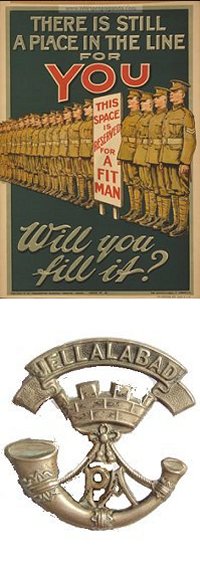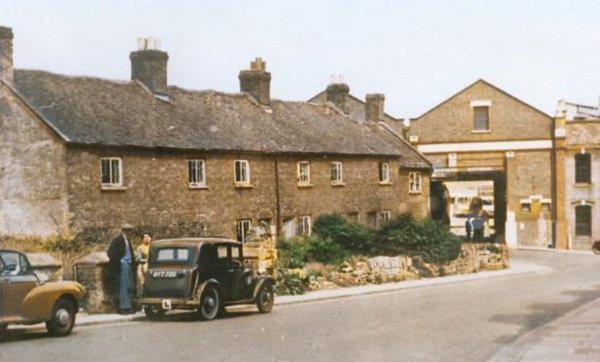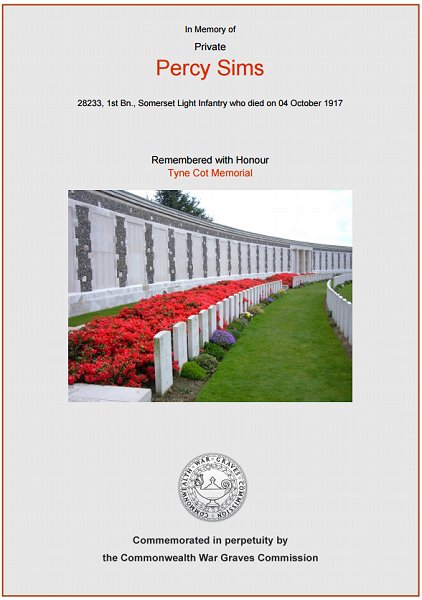yeovil at War
Percy Sims
Killed in action at the Battle of Broodseinde
Percy Sims was born in Yeovil in 1898, the youngest of the six children of coal merchant's carter John William Sims (1853-1933) and Susan (née Mann?) (b1852). John and Susan had a total of eleven children but five died in infancy. The surviving children were Frank (b1882), Ernest Thomas (b1885), Elsie (b1887), William (b1889), Rose (b1895) and Percy (1898-1917). Other than Frank (who was born in Newport, Wales) all the children were born in Yeovil.
The family had lived in Sparrow Lane before Percy was born, but he was born in Queen Street. By 1901 the family were living at 9 Reckleford Hill, between Mary Street and Goldcroft (see Gallery). By 1911 the family had moved to 120 Park Street. John was now a travelling salesman and Percy was still at school.
 Percy
enlisted at
Yeovil, joining
the 1st
Battalion,
Somerset Light
Infantry.
Assuming he
didn't enlist
under age, he
would have
enlisted in late
1916 but his
Service Number
28233 suggests
it would more
likely have been
during early
1917.
Percy
enlisted at
Yeovil, joining
the 1st
Battalion,
Somerset Light
Infantry.
Assuming he
didn't enlist
under age, he
would have
enlisted in late
1916 but his
Service Number
28233 suggests
it would more
likely have been
during early
1917.
In 1917 the 1st Battalion were at Arras, in action during the the First and Third Battles of the Scarpe, before heading north for the Third Battle of Ypres, where they fought in the Battle of Polygon Wood, the Battle of Broodseinde, the Battle of Poelcapelle and the First Battle of Passchendaele.
The Second Battle of Arras, fought between 9 April and 16 May 1917, was the British contribution to the Allied spring offensive of 1917. The original Allied plan for 1917, agreed at the Chantilly conference of November 1916, was for a second offensive on the Somme, but that plan was abandoned after a change of French leadership and it was decided that the British would attack around Arras and involve troops from three armies. In the north the Canadian corps of the First Army would attack Vimy Ridge. In the centre of the line the Third Army under General Allenby would attack from Arras. Finally, the British Fifth Army under General Gough would attack on the right of the line. The entire British attack was supported by 2,879 guns each of which had close to 1,000 shells. The British attack made impressive progress, but it did not achieve a breakthrough on the first day, allowing the Germans to rush their reinforcements into the gap and launch a series of counterattacks thereby slowing down the British attack. A renewed British attack at Bullecourt on 11 April failed to make any progress and the attack was suspended. The month of fighting around Arras cost the British 84,000 casualties and the Germans 75,000. Tactically it was a clear British victory, but the overall plan to cut off the German salient had failed.
Field Marshal Sir Douglas Haig thought that Flanders presented a much more attractive target than the Somme as it was close to the main British sources of supply, was familiar to his staff and offered the chance of a breakthrough with targets such as the German railhead at Roulers and the Channel ports from which German submarines were conducting operations (he was under pressure from the Admiralty to clear the Flanders coast). The attack was preceded by the assault of Plumer's Second Army on Messines on 7 June 1917 with the main attack coming on 31 July from Gough's Fifth Army - a little too late as it happens for the momentum had been lost in the interval. It consisted of three phases - the first being the battles for Pilckem Ridge, Gheluvelt Plateau and Langemarck where the Fifth Army pushed its way into a salient made all the more boggy by unseasonal weather and the shelling had badly damaged the land drainage system.
Secondly, Second Army took over with the battles for Menin Road Ridge, Polygon Wood and Broodseinde, making good progress in the central sector. Finally, in the battles for Poelcappelle and Passchendaele the attackers, who were by this time exhausted, fought their way onto Passchendaele Ridge in appalling conditions, with the Canadians taking the village on 6 November 1917. The British lost well over 200,000 men, with the Germans losing a similar figure and the battle badly affected the morale of both sides, with the word 'Passchendaele' becoming a byword for suffering.
The Battle of Polygon Wood, 25-27 September 1917, was part of the wider Third Battle of Ypres. It came during the second phase of the battle, in which General Herbert Plumer’s Second Army was given the lead. Plumer replaced the ambitious general assaults that had begun the battle with a series of small attacks with limited objectives – his “bite and hold” plan. These attacks involved a long artillery bombardment followed by an attack on a narrow front (2,000 yards wide at Polygon Wood). The attacks were led by lines of skirmishers, followed by small infantry groups. German strong points were to be outflanked rather than assaulted. Each advance would stop after it had moved forward 1,000-1,500 yards. Preparations were then made to fight off any German counterattack. The attack on Polygon Wood was the second of Plumer’s “bite and hold” attacks, after Menin Road. It was carried out chiefly by the 4th and 5th Australian Divisions but the 1st Battalion, Somerset Light Infantry also played a part. The target was a line just beyond Polygon Wood (a wood in name only by 1917, having lost all of its trees in earlier fighting). The site of Polygon Wood was captured on 26 September, the target line on 27 September. The attack then stopped, and Plumer prepared for the next attack. The two Australian divisions lost 5,471 men during the Battle of Polygon Wood. The three “bite and hold” attacks brought the front line to the foot of the Passchendaele Ridge, which would be come the target of the First and Second Battles of Passchendaele, and give its name to the entire battle.
The Battle of Broodseinde, 4 October 1917, was the last of three successful “bite and hold” battles launched by General Herbert Plumer during the middle phase of the Third Battle of Ypres. Both sides were planning an attack on 4 October. When the British bombardment began, it caught a number of German units out in the open preparing for their own attack. The British attack contained divisions from Britain, New Zealand and Australia. As at Menin Road Ridge and Polygon Wood, the British attack achieved its main objectives and then halted to dig in. Although these attacks are normally described as small scale battles, the casualty figures demonstrate the real scale of the fighting. The Germans suffered 10,000 casualties and lost 5,000 prisoners. On the Allied side the Australians suffered 6,432 casualties, the New Zealanders 892 and the British 300. Among these was Percy Sims who fell on 4 October 1917 at the age of just 19.
Percy Sims is remembered on the Tyne Cot Memorial, West Vlaanderen, Belgium, Panels 41 to 42 and 163A. His name was added to the War Memorial in the Borough in 2018.
gallery

This
photograph
features in my
book "Lost Yeovil"
Cottages on Reckleford by Goldcroft. Photographed in the early 1960s. These were demolished soon after this photograph was taken. One of them (not sure which) was the home of the Sims family in 1901.

The Commonwealth War Graves Commission certificate in memory of Percy Sims.